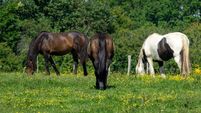Precious metals tell tale of real core value
But for those who laboured underground, the price paid was often devastatingly high. There was great wealth for a few, and back-breaking work — often in deplorable conditions — for the many. Cornwall has a long history of mining which stretches back into prehistoric times. During mining’s heyday a philanthropic doctor recorded that Cornish miners routinely descended 2,000 feet of ladders to begin work and that this took them an hour going down, but after gruelling 12 hour shifts, at least two hours to ascend. He pointed out that when the miners finally emerged. they looked thin and their arms seemed to be of an unnatural length.
There were cave-ins, flooding, explosions and diseases that ravaged mining populations to contend with too. Miners died early of silicosis and cholera. In St Cleer, a Cornish mining village, this same doctor recorded that the average life expectancy of a miner was just 28. And there was the insidious practice of forcing miners to buy their food and other essentials from shops run by those who controlled the mines, frequently at vastly inflated prices, the costs deducted from their meagre wages.
By the early 1800s, rapid developments in machinery allowed for ever-deeper shafts to be dug and by 1837 Cornwall was producing two thirds of the world’s copper supply. But for the workingmen, women and children of Cornwall, this meant little. Gin-shops, poverty and damp, inadequate hovels housed the ever-increasing population who could no longer rely on farming or fishing to eke out a livelihood. By 1837, the population of Cornwall was more numerous than it is today.
Little wonder then that after the harsh winter of 1846/ bands of hungry miners invaded Cornish town in a desperate attempt to prevent merchants sending corn out of the county. During this time many miners and their families left for the lead regions of Wisconsin.
When John Wesley had first brought Methodism to Cornwall in 1743, he encountered a population of starving, hard-drinking tinners, wreckers, smugglers and an indifferent clergy. Yet despite fierce opposition to his teachings, over 50 years the indefatigable Wesley had transformed the lives of many formerly hopeless Cornish, some of whom carried his austere doctrine with them when they came to work in the mines of Beara in the early 1800s.
There was a saying among the Cornish at the time that ” “wherever a hole is sunk, there you will find a Cornishman digging”. But their expertise was not always welcomed by the hard-pressed Beara population who feared for their own jobs and who, like the Cornish, had endured years of deprivation and appalling working conditions.
Nevertheless, the Cornish workers settled, established their own village community in the hills near the mines and built their own school and Methodist chapel which today houses the fascinating Allihies Copper Mine Museum. Mining began in Allihies at the Dooneen mine in 1812. By 1831, the mines employed over 1,000 people.
A number of companies were incorporated by an Act of Parliament to work mines throughout Ireland. But many of these companies were fraudulent designed to profit only the promoters and directors. For a time, the mines prospered, but around 1850 profits began to decline, and conditions for workers became considerably worse. Many Cornish Irish miners emigrated, often to seek their fortunes in Butte Montana.
The Allihies Copper Mine Museum offers a comprehensive record of this fascinating story, at the same time presenting a rich picture of social history through photos, exhibits and interactive displays. And as if all that were not quite enough, the elegant museum café also provides some of the best coffee to be found on the Beara Peninsula.
The UK Association for Industrial Archaeology presented the museum with two prestigious awards last week. I caught up with Tadhg O’Sullivan, vice-chairman of the Allihies Parish Cooperative, to find out more.
Q Congratulations on the award Tadhg. Two in one, I believe?
A We won The Best Site Visited award and a second for “A challenging task taken on in an innovative manner”. They were presented to our chairman, Charles Tyrell. The second award was more focused on projects that are in harmony with the environment. We were chosen as the best out of 15 sites visited, which is a great compliment to the museum and those who have worked on this project.
Q It must have been quite a day for you.
A It was great. Even the weather was good so we could sit outside and enjoy it. It was a special weekend in Allihies. Apart from the awards, there was a music festival, set-dancing exhibitions from the children and music in the café from fiddler John Dwyer.
Q This success obviously hasn’t happened overnight. When did you begin work on the museum project?
A “In about 1999. We had a lot of meetings, talked about how we visualised it coming into being and what the project could do for the community. One of the first things we agreed on was that we had to have a really good coffee machine!”
Q And you succeeded! The coffee is really great. In fact I would imagine that many visitors are surprised at how elegant and stylish the museum and coffee shop are.
A “You’re right. I think a lot of visitors to Allihies are pleasantly surprised at how much there is going on here. The Language School, for instance, and a series of festival and exhibitions by the many artists who live in this area. And our museum and café, of course. Allihies is a beautiful place where the bare bones of the earth are dramatically exposed and you can see the Skelligs from Ballydonegan Beach. There’s nowhere like it.”
Q Between the farming and your role in the Parish Cooperative, you must be kept pretty busy.
A “I joined the co-op in 1996 and became involved with a Community Employment Scheme and a number of other projects. Then we became involved with restoring the old Methodist Chapel and the museum scheme. It took a number of years to get everything right. But we are custodians of an important story which reaches into the heart of the community and has helped shape its identity. President McAleese officially opened the museum in 2007, We are currently compiling books and relevant documents to add to our reference library.
Q I believe you’re not resting on your laurels any time soon either. There are some exciting new plans afoot, I’ve heard.
A “That’s right. We’ve already completed a feasibility study to open one of the mines as an underground attraction. And while we obviously want visitors to come to Beara, like the museum, everything has to be done in harmony with the environment. People come here for the gentler pace of life, the beauty and the friendliness of the people and we don’t want that to change. But I can tell you that it’s really going to be something special.”












